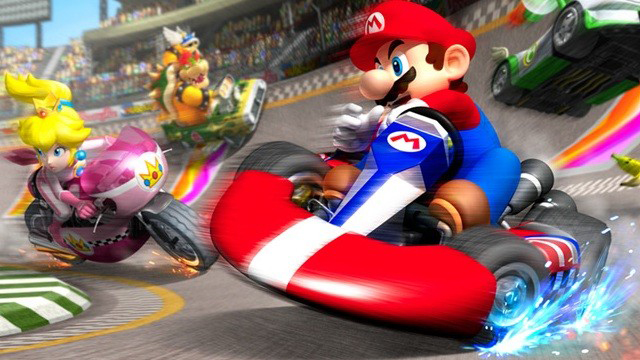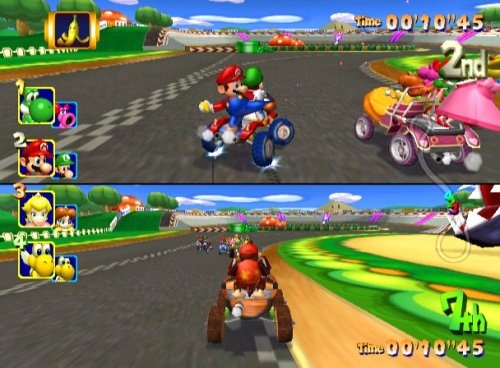
After 3DS released to poor sales and endless doom and gloom from every corner of the Internet, I developed a saying that I continue to use to this day in conversations about Wii U: “You can’t judge a Nintendo console, until it gets its Mario Kart title.” The idea behind this statement is really quite simple: the Mario Kart franchise is such a heavy hitter that it only seems pointless to speculate about how successful or significant a Nintendo console is until it hits the market. By no means does a new Mario Kart always mean that the system will become an instant success, but it almost seems like each console defines the game as much as the game ends up defining the console.
The root of my theory really comes from the time I spent working at GameStop (yeah, I was a shill for preorders and Game Informer subscriptions), which included the 2008 and 2009 holiday seasons. What really amazed me during these periods of unabashed materialism was just how popular Mario Kart was, both for Wii and DS. Remember, Mario Kart Wii came out in April of 2008, and by the time the holidays rolled around each shipment quickly sold out, and then in 2009 the exact same thing happened. Think about that; that is two straight holidays, with the first being six months after the initial release, where the game was nearly impossible to find. As for Mario Kart DS, it came out in November of 2005 and it too was selling out in ’08 and ’09, so three and four years after it first launched. Plenty of games become hard to find after a few years due to a lack of inventory, but for a game that stayed in continuous production for so long to keep selling out is kind of crazy.
After having witnessed this sheer love for the series from gamers young and old, and knowing that Mario Kart 7 was coming sooner rather than later, I reserved judgment on the 3DS situation and was proven correct. Alongside the likes of Super Mario 3D Land, Mario Kart 7 turned around public perception of 3DS and became a massive success in its own right. For those who remember back to 2005, this whole situation created a very strong sense of deja vu. The original DS had a very similar, disappointingly slow launch that left many gamers doubtful the system could ever achieve a fraction of the success of the Game Boy line, and then Mario Kart DS opened the floodgates and the system ultimately went on to far exceed its predecessors and contemporaries by tens of millions of units. While it would be foolish to expect Mario Kart 7, or even 3DS itself, to match what happened with DS, you still have to give the game credit for giving the handheld a much needed boost.

Will anti-gravity be this innovative? Or will it even matter?
If we look back to Mario Kart: Double Dash!! for GameCube, we find a significantly different relationship between the game and its console. GameCube fell well short of Wii’s massive success, nor did its slow start receive a Mario Kart fueled boost like DS and 3DS, but I think its status as an underappreciated console goes hand in hand with the game. Double Dash!! was released in November of 2003, and while it was well received critically and sold well by GameCube standards, I seem to remember a surprising lack of excitement for the game around launch. Perhaps this was just a reflection of the apathy many had toward GameCube. However, just as the console would receive more love after the console generation, I think the same is happening for Double Dash!! because as much as we might love all the newer entries and what they have done for the series, Double Dash!! was far and away the most ambitious in the series in terms of adding to the gameplay. While the gameplay has seen its fair share of tweaks and each successive entry has improved the online experience, the addition of cooperative racing between two characters offered another layer of strategy, and a new way to enjoy the game with friends.
Everything mentioned above leaves me somewhat ambivalent about Mario Kart 8. On the one hand, the franchise has proven to be a major system seller on DS, Wii, and 3DS, so that has me excited for what it could potentially do for the struggling Wii U. And then there is the unfortunate fact this once again looks to be more of an evolutionary entry in the series. The addition of anti-gravity sections of track will no doubt prove to be an exciting addition to the tried and true gameplay, and will most likely prove to be the most significant innovation since the cooperative element in Double Dash!!, but I can’t help but feel it won’t meet, let alone surpass, the impact that feature had on the core gameplay. Taking the sheer potential of what could be done with the GamePad just serves to raise further questions about why Nintendo isn’t taking more risks with Mario Kart 8.
Despite the dour direction the last paragraph ended up going, I am ultimately hopeful and excited for Mario Kart 8. Wii U continues to need high quality games that can sell consoles, and the last decade has proven that few franchises in the entire industry are as capable as Mario Kart. Even though Nintendo might have dialed back the level of innovation in these more recent entries, they remain immensely fun, engaging, and even visually stunning. So, regardless of what Mario Kart 8 ultimately accomplishes in terms of selling consoles and evolving the franchise, precedent suggests we should at least be getting a great game.




 ShareThis
ShareThis






